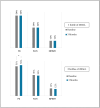Effectiveness of High-Protein Energy-Dense Oral Supplements on Patients with Malnutrition Using Morphofunctional Assessment with AI-Assisted Muscle Ultrasonography: A Real-World One-Arm Study
- PMID: 39339736
- PMCID: PMC11435358
- DOI: 10.3390/nu16183136
Effectiveness of High-Protein Energy-Dense Oral Supplements on Patients with Malnutrition Using Morphofunctional Assessment with AI-Assisted Muscle Ultrasonography: A Real-World One-Arm Study
Abstract
Background: User-friendly tools for assessing nutrition status and interventions in malnourished patients are crucial. This study evaluated the effectiveness of a personalised nutrition intervention using a novel oral nutritional supplement and AI-supported morphofunctional assessment to monitor clinical outcomes in patients with disease-related malnutrition (DRM). Methods: This prospective observational study involved patients receiving concentrated high-protein, high-calorie ONS (cHPHC-ONS), per usual clinical practice. Comprehensive assessments were performed at baseline (B0) and three months (M3) post-intervention. Results: 65 patients participated in the study. Significant decreases were observed in the percentage weight loss from B0 (-6.75 ± 7.5%) to M3 (0.5 ± 3.48%) (p < 0.01), in the prevalence of malnutrition (B0: 93.4%; M3: 78.9%; p < 0.01), severe malnutrition (B0: 60.7%; M3: 40.3%; p < 0.01), and sarcopenia (B0: 19.4%; M3: 15.5%; p < 0.04). Muscle area increased (p = 0.03), and there were changes in the echogenicity of the rectus femoris muscle (p = 0.03) from B0 to M3. In patients aged ≥60, an increase in muscle thickness (p = 0.04), pennation angle (p = 0.02), and handgrip strength (p = 0.04) was observed. There was a significant reduction in the prevalence of malnutrition (B0: 93.4%; M3: 78.9%; p < 0.01) and severe malnutrition (B0: 60.7%; M3: 40.3%; p < 0.01). Conclusions: In patients with DRM, a personalised intervention with cHPHC-ONS significantly reduces the prevalence of malnutrition, severe malnutrition, and sarcopenia and improves muscle mass and function.
Keywords: artificial intelligence; malnutrition; nutritional support; sarcopenia.
Conflict of interest statement
J.J.L. has received support for the development of the present manuscript by Nestlé Healthcare. J.J.L. has received payment or honoraria for lectures, presentations, participation in speakers’ bureaus, manuscript writing, or educational events from Nestlé Healthcare, Vegenat Healthcare, Abbott Nutrition, Persan Pharma, Adventia Pharma, and Nutricia. Additionally, J.J.L. has been supported for attending meetings and/or travel by Adventia Pharma, Nutricia, and Persan Pharma. Furthermore, J.J.L. has participated on Data Safety Monitoring Boards or Advisory Boards for Abbott Nutrition, Nutricia, Persan Pharma, Vegenat Healthcare, and Nestlé Healthcare. The other authors have no conflicts of interest to declare.
Figures







References
-
- Pradelli L., Zaniolo O., Sanfilippo A., Lezo A., Riso S., Zanetti M. Prevalence and Economic Cost of Malnutrition in Italy: A Systematic Review and Metanalysis from the Italian Society of Artificial Nutrition and Metabolism (SINPE) Nutrition. 2023;108:111943. doi: 10.1016/j.nut.2022.111943. - DOI - PubMed
-
- Kaiser M.J., Bauer J.M., Rämsch C., Uter W., Guigoz Y., Cederholm T., Thomas D.R., Anthony P.S., Charlton K.E., Maggio M., et al. Frequency of Malnutrition in Older Adults: A Multinational Perspective Using the Mini Nutritional Assessment. J. Am. Geriatr. Soc. 2010;58:1734–1738. doi: 10.1111/j.1532-5415.2010.03016.x. - DOI - PubMed
-
- Zugasti-Murillo A., Petrina-Jáuregui M.E., Ripa-Ciáurriz C., Sánchez-Sánchez R., Villazón-González F., Faes Á.G.D., Fernández-López C., Calles-Romero L., Martín-Palmero Á., Riestra-Fernández M., et al. Sedreno Study—Prevalence of Hospital Malnutrition according to Glim Criteria, Ten Years after the Predyces Study. Nutr. Hosp. 2021;38:1016–1025. doi: 10.20960/nh.03638. - DOI - PubMed
Publication types
MeSH terms
Substances
LinkOut - more resources
Full Text Sources
Medical

